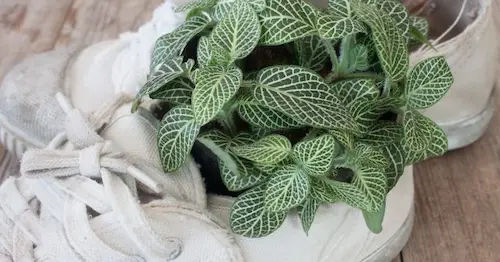Fittonia Care Singapore

Fittonia, or the Nerve Plant, is a vibrant, decorative plant known for its beautiful, veined leaves. This guide will help you cultivate Fittonia successfully in Singapore’s tropical climate.
Understanding Fittonia
Fittonia, also known as the Nerve Plant, is prized for its striking, mosaic-like foliage. With varieties like Fittonia albivenis and Fittonia verschaffeltii, these plants typically grow to about 10-15 cm, making them perfect for terrariums or as indoor plants.
Optimal Growing Conditions
Light Requirements
Fittonia thrives in bright, indirect light. Direct sunlight can scorch the leaves, so it’s best to place the plant away from direct sunlight. If natural light is insufficient, artificial grow lights can be a good alternative.
Temperature and Humidity
Being a tropical plant, Fittonia prefers temperatures between 18°C and 24°C, which is easily achievable indoors in Singapore. High humidity is crucial, ideally between 70-90%. Use a humidifier, mist the plant regularly, or place it on a tray with pebbles and water to maintain humidity.
Soil and Potting
Fittonia needs well-draining soil to prevent root rot. A mix of peat moss, perlite, and potting soil works well. Ensure the pot has drainage holes, and consider terracotta pots, which help regulate soil moisture.
Watering Guidelines
- Frequency: Water your Fittonia when the top inch of soil feels dry. Consistency is key, keeping the soil moist but not waterlogged.
- Seasonal Adjustments: During dormancy, reduce watering frequency. Mist the leaves regularly to maintain humidity, especially in drier conditions.
Fertilization
Feed your Fittonia with a balanced liquid fertilizer every four to six weeks during the growing seasons (spring and summer). In the fall and winter, reduce fertilization to every eight to ten weeks. Use half-strength solutions to avoid burning the leaves.
Common Problems and Solutions
Pests and Diseases
Fittonia can be affected by spider mites and aphids. Use insecticidal soap or neem oil to treat these pests. Ensure good air circulation to prevent fungal issues like powdery mildew.
Leaf Issues
Yellow leaves typically indicate overwatering, while brown edges suggest low humidity. Adjust your watering schedule and increase humidity to resolve these problems. Curling leaves can be a sign of underwatering or too much direct sunlight.
Pruning and Maintenance
- Regular Pruning: Trim stringy stems to maintain a bushy appearance. Prune any roots that sprout along the vines.
- Leaf Care: Regularly remove dead or damaged leaves. Clean the leaves with a damp cloth to remove dust, ensuring the plant can breathe and absorb light effectively.
Propagation Methods
- Stem Cuttings: Use stem cuttings to propagate Fittonia. Place the cuttings in water or a humid environment until roots develop.
- Planting: Once the roots are established, plant the cuttings in well-draining soil. This method helps expand your Fittonia collection or share with friends.
Benefits of Growing Fittonia
Fittonia not only adds beauty to indoor spaces with its colorful foliage but also helps improve air quality by removing pollutants. It’s an excellent choice for terrariums, contributing to a miniature ecosystem.
Fittonia Care Singapore
By following these care tips, you can enjoy the vibrant beauty of Fittonia in your home, adding a touch of tropical charm to your indoor garden. Fittonia not only beautifies your space but also contributes to a healthier living environment by purifying the air. Whether you’re a seasoned gardener or a beginner, Fittonia is a delightful plant that rewards your care with its lush, colorful foliage.
Frequently Asked Questions (FAQ)
If you have any questions about Fittonia care in Singapore, you can refer to the frequently asked questions (FAQ) about Fittonia Caring in Singapore below:
What are the light requirements for Fittonia plants?
Fittonia plants, also known as nerve plants or mosaic plant, thrive in bright, indirect sunlight. Direct sun can scorch their delicate fittonia leaves, so it’s essential to keep them in a location with filtered light. This indoor plant prefers bright conditions but not direct exposure, making it perfect for indoor spaces.
How should I water my Fittonia plant to avoid root rot?
Fittonia plants require a consistently moist but not soggy soil. Use a well-draining soil mix to prevent water from pooling at the roots. Water the plant when the top inch of soil feels dry, and make sure to use pots with drainage holes. Regularly mist the leaves to maintain high humidity, which is vital for these tropical plants.
What type of soil is best for growing Fittonia plants?
A well-draining soil mix is crucial for Fittonia plants to avoid root rot. A combination of peat moss, perlite, and regular potting soil works well. This mix retains enough moisture while allowing excess water to drain away, keeping the roots healthy. Fittonia plants, originating from South America, thrive in this kind of environment.
Can Fittonia plants be grown in hanging baskets?
Yes, Fittonia plants can be grown in hanging baskets, which can enhance their aesthetic appeal. When planting in hanging baskets, ensure the baskets have proper drainage and use a well-draining soil mix. Regular misting and monitoring of soil moisture are important to keep the plants healthy and vibrant in this setup, similar to what is recommended in terrarium workshops.
What are the common problems faced when growing Fittonia plants?
Common issues with Fittonia plants include leaf discoloration and pests. Yellow leaves often indicate overwatering, while brown edges suggest low humidity. Spider mites and aphids can also affect Fittonia plants; treating them with insecticidal soap or neem oil can help. Ensuring good air circulation and keeping the plants away from direct sun can prevent most problems. Fittonia prefers bright, indirect light and a humid environment, so regularly misting the leaves is essential.
